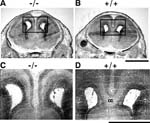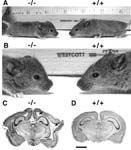Phenotypes associated with this allele
|
|
| Find Mice |
Using the International Mouse Strain Resource (IMSR)
Mouse lines carrying:
Nfiatm1Rmg mutation
(1 available);
any
Nfia mutation
(28 available)
|
|
|

Absence of corpus callosum in Nfiatm1Rmg/Nfiatm1Rmg mice
mortality/aging
|
|
• more than 90% die postnatally
|
nervous system
|
|
• although callosal axons approach the midline, they fail to cross and extend aberrantly into the septum
• overlap of the axons in the corpus callosum and fornix and the corpus callosum and the hippocampal commissure
|
|
|
• sling cells, which contribute to the development of the corpus callosum, are generated but migrate abnormally into the septum and do not form a sling
|
|
|
• hippocampal commissure is absent or reduced
|
|
|
• glia within the hippocampus, particularly the dentate gyrus and the fimbria are reduced
|
|
|
• glia within the indusium griseum and the glial wedge are greatly reduced or absent
• glia within the hippocampus, particularly the dentate gyrus and the fimbria are reduced
• formation of the midline zipper glial population is disrupted, with glia either absent or shifted position
• glial tunnel is greatly reduced surrounding a smaller anterior commissure
|
cellular
|
|
• although callosal axons approach the midline, they fail to cross and extend aberrantly into the septum
• overlap of the axons in the corpus callosum and fornix and the corpus callosum and the hippocampal commissure
|
|
|
| Find Mice |
Using the International Mouse Strain Resource (IMSR)
Mouse lines carrying:
Nfiatm1Rmg mutation
(1 available);
any
Nfia mutation
(28 available)
|
|
|

Hydrocephalus in Nfiatm1Rmg/Nfiatm1Rmg mice
mortality/aging
|
|
• about 95% die within 2 weeks of birth, with most dying on the day of birth
|
growth/size/body
|
|
• the rare survivors have a domed head, however this phenotype diminishes with time and adults appear relatively normal
|
|
|
• the rare survivors are runted for the first two weeks of life
|
nervous system
|
|
• survivors display hydrocephalus, however this phenotype diminishes with time in most mutants except for a few rare adults that exhibit severe hydrocephalus
|
|
|
• rare adults show dilation of the lateral ventricles
|
|
|
• rare adults show dilation of the third ventricles
|
behavior/neurological
|
|
• rare surviving mice possess a tremor
|
reproductive system
 |
• surviving females have low fecundity but are able to give birth and suckle young
|
 |
• adult males appear sterile, however histological examination of testes reveals no gross abnormalities
|
craniofacial
|
|
• the rare survivors have a domed head, however this phenotype diminishes with time and adults appear relatively normal
|
|
|
| Find Mice |
Using the International Mouse Strain Resource (IMSR)
Mouse lines carrying:
Nfiatm1Rmg mutation
(1 available);
any
Nfia mutation
(28 available)
|
|
|

Spectrum of kidney histology in Nfiatm1Rmg/Nfiatm1Rmg newborns
nervous system
|
|
• 66% of newborns exhibit syringomyelia that is manifested as an enlarged central canal and confined to the lumbar region
|
renal/urinary system
|
|
• 68% of newborns display agenesis, dysplastic, cystic, or duplex kidneys
|
|
|
• two mice that survive to P16 develop severe hydronephrosis
|
|
|
• some newborns exhibit bilateral renal agenesis
|
|
|
• newborns exhibit duplication and dilatation of the ureter at the ureteropelvic junction
|
|
|
• newborns exhibit duplication and dilatation of the ureter at the ureteropelvic junction
|
growth/size/body
|
|
| Find Mice |
Using the International Mouse Strain Resource (IMSR)
Mouse lines carrying:
Nfiatm1Rmg mutation
(1 available);
any
Nfia mutation
(28 available)
|
|
|
mortality/aging
nervous system
|
|
• at P17, mice exhibit a deformed foliation pattern whereby fissures are reduced in depth and lobules are either stunted or poorly defined
|
|
|
• at P17, dendrite formation is dramatically impaired on cerebrellar granule neurons (GCNs) through out the inner granule layer of more anterior lobules
• GCN nuclei are observed in the molecular layer
|
|
|
• at P17, molecular layer axons are extremely short through both anterior and posterior aspects of the vermis
• GCN nuclei are observed in the molecular layer
|
Allelic
Composition |
Nfiatm1Rmg/Nfia+
|
|
Genetic
Background |
involves: 129P2/OlaHsd * Black Swiss |
|
| Find Mice |
Using the International Mouse Strain Resource (IMSR)
Mouse lines carrying:
Nfiatm1Rmg mutation
(1 available);
any
Nfia mutation
(28 available)
|
|
|
cellular
|
|
• loss of heterozygous progeny is seen only when the mutant allele is transmitted from the female parent, suggesting a maternal effect
|
Allelic
Composition |
Nfiatm1Rmg/Nfia+
|
|
Genetic
Background |
involves: 129P2/OlaHsd * C57BL/6 |
|
| Find Mice |
Using the International Mouse Strain Resource (IMSR)
Mouse lines carrying:
Nfiatm1Rmg mutation
(1 available);
any
Nfia mutation
(28 available)
|
|
|

Ureter defects in Nfiatm1Rmg/Nfiatm1Rmg and Nfiatm1Rmg/Nifia+ mice
renal/urinary system
|
|
• 22% of newborns exhibit hydronephrosis
|
|
|
• newborns exhibit duplication and dilatation of the ureter at the ureteropelvic junction
|
|
|
• newborns exhibit duplication and dilatation of the ureter at the ureteropelvic junction
|
|
|
• some newborns exhibit dilation of the ureterovesical junction
|
|
|
| Find Mice |
Using the International Mouse Strain Resource (IMSR)
Mouse lines carrying:
Nfiatm1Rmg mutation
(1 available);
any
Nfia mutation
(28 available)
Tg(Hoxb7-EGFP)33Cos mutation
(1 available)
|
|
|

Nfiatm1Rmg/Nfia+ Tg(Hoxb7-EGFP)33Cos and Nfiatm1Rmg/Nfiatm1Rmg Tg(Hoxb7-EGFP)33Cos mice have ureteral defects
renal/urinary system
|
|
• 33% of mutants exhibit ureteral development abnormalities, that include proximal flexion of the ureter and ureter dilation
|
|
|
| Find Mice |
Using the International Mouse Strain Resource (IMSR)
Mouse lines carrying:
Nfiatm1Rmg mutation
(1 available);
any
Nfia mutation
(28 available)
Tg(Hoxb7-EGFP)33Cos mutation
(1 available)
|
|
|

Nfiatm1Rmg/Nfia+ Tg(Hoxb7-EGFP)33Cos and Nfiatm1Rmg/Nfiatm1Rmg Tg(Hoxb7-EGFP)33Cos mice have ureteral defects
renal/urinary system
|
|
• 22% exhibit ureteral development abnormalities that include ureter dilation and partial ureteral duplication
|



 Analysis Tools
Analysis Tools

